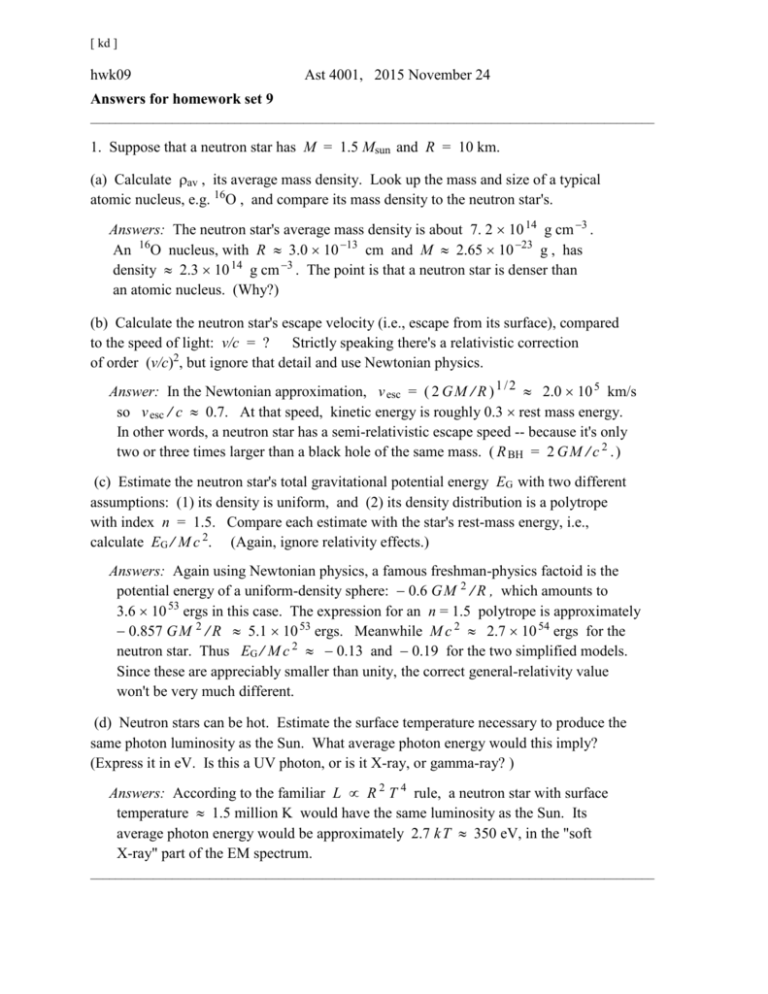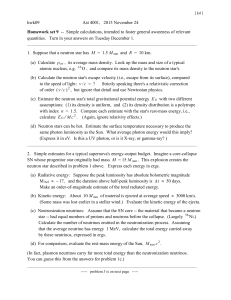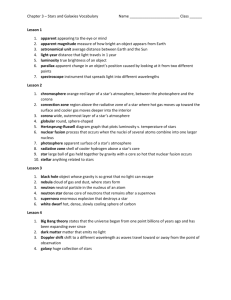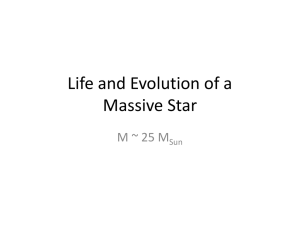hwk09ans
advertisement

[ kd ] hwk09 Ast 4001, 2015 November 24 Answers for homework set 9 __________________________________________________________________________________________ 1. Suppose that a neutron star has M = 1.5 Msun and R = 10 km. (a) Calculate av , its average mass density. Look up the mass and size of a typical atomic nucleus, e.g. 16O , and compare its mass density to the neutron star's. Answers: The neutron star's average mass density is about 7. 2 10 14 g cm . An 16O nucleus, with R 3.0 10 cm and M 2.65 10 g , has density 2.3 10 14 g cm . The point is that a neutron star is denser than an atomic nucleus. (Why?) (b) Calculate the neutron star's escape velocity (i.e., escape from its surface), compared to the speed of light: v/c = ? Strictly speaking there's a relativistic correction 2 of order (v/c) , but ignore that detail and use Newtonian physics. Answer: In the Newtonian approximation, v esc = ( 2 G M / R ) 1 / 2 2.0 10 5 km/s so v esc / c 0.7. At that speed, kinetic energy is roughly 0.3 rest mass energy. In other words, a neutron star has a semi-relativistic escape speed -- because it's only two or three times larger than a black hole of the same mass. ( R BH = 2 G M / c 2 . ) (c) Estimate the neutron star's total gravitational potential energy EG with two different assumptions: (1) its density is uniform, and (2) its density distribution is a polytrope with index n = 1.5. Compare each estimate with the star's rest-mass energy, i.e., calculate EG / M c 2. (Again, ignore relativity effects.) Answers: Again using Newtonian physics, a famous freshman-physics factoid is the potential energy of a uniform-density sphere: 0.6 G M 2 / R , which amounts to 3.6 10 53 ergs in this case. The expression for an n = 1.5 polytrope is approximately 0.857 G M 2 / R 5.1 10 53 ergs. Meanwhile M c 2 2.7 10 54 ergs for the neutron star. Thus EG / M c 2 0.13 and 0.19 for the two simplified models. Since these are appreciably smaller than unity, the correct general-relativity value won't be very much different. (d) Neutron stars can be hot. Estimate the surface temperature necessary to produce the same photon luminosity as the Sun. What average photon energy would this imply? (Express it in eV. Is this a UV photon, or is it X-ray, or gamma-ray? ) Answers: According to the familiar L R 2 T 4 rule, a neutron star with surface temperature 1.5 million K would have the same luminosity as the Sun. Its average photon energy would be approximately 2.7 k T 350 eV, in the "soft X-ray" part of the EM spectrum. __________________________________________________________________________________________ 4001hwk09ans - p2 __________________________________________________________________________________________ 2. Simple estimates for a typical supernova's energy-output budget. Imagine a core-collapse SN whose progenitor star originally had mass M = 15 M sun. This explosion creates the neutron star described in problem 1 above. Express each energy in ergs. (a) Radiative energy: Suppose the peak luminosity has absolute bolometric magnitude M bol and the duration above half-peak luminosity is t 50 days. Make an order-of-magnitude estimate of the total radiated energy. Answer: Roughly 10 49 ergs. M bol corresponds to L 5 10 8 L sun 2 10 42 ergs s. Multiply by 50 days and we get 8.6 10 48 ergs. (b) Kinetic energy: About 10 M sun of material is ejected at average speed 3000 km/s. (Some mass was lost earlier in a stellar wind.) Evaluate the kinetic energy of the ejecta. Answer: Roughly 10 51 ergs, 100 the radiated energy. ( M v 2 / 2 9 10 50 ergs . ) (c) Neutronization neutrinos: Assume that the SN core -- the material that became a neutron star -- had equal numbers of protons and neutrons before the collapse. (Largely 56Ni.) Calculate the number of neutrinos emitted in the neutronization process. Assuming that the average neutrino has energy 1 MeV, calculate the total energy carried away by these neutrinos, expressed in ergs. Answers: Most of the protons are converted to neutrons, and each proton-to-neutron conversion creates one neutrino. There are about 9 10 56 protons in the pre-SN material that became a neutron star, so that is the number of neutronization-neutrinos. Concerning energy, 9 10 56 MeV 1.4 10 51 ergs. This may be an underestimate because the average neutrino energy may be larger than 1 MeV. (In reality, plasmon neutrinos carry far more. According to problem 1c, the formation of a neutron star releases more than 10 53 ergs and this has to be removed somehow. "Somehow" is mostly neutrinos made by processes other than p n.) (d) For comparison, evaluate the rest-mass energy of the Sun, M sun c 2. Answer: 1.8 10 54 ergs. The order of magnitude, 10 54 ergs, is worth remembering. (Also remember that the number of baryons in the Sun is of order 10 57 .) __________________________________________________________________________________________ ----- problem 3 is on next page ----- 4001hwk09ans - p3 __________________________________________________________________________________________ 3. In an order-of-magnitude sense, the fundamental pulsation period of a star is fairly close to the "dynamical timescale" t dyn = (G), where we'll assume in this problem that = average internal mass density. Evaluate the dynamical timescale for each of the following objects. You may need to look up most of the necessary masses and sizes, or even make intelligent guesses; in any case specify what numbers you've assumed. Express each value in an appropriate unit of time for that object: s, ms, seconds, minutes, hours, days, months, years, or whatever fits it best. (a) The Sun. Answer: About 0.9 hour. ( density 1.4 g cm) (b) Planet Earth. Answer: A little less than half an hour. ( density 5.5 g cm) (c) The red supergiant star Orionis = Betelgeuse. Answer: Roughly 1.5 year. This star allegedly has M 7.7 M sun and R 1180 R sun , implying average density 6.6 10 g cm . (d) Sirius B. Answer: About 2.5 seconds. ( density 2.3 10 g cm . ) (e) The neutron star described in problem 1. Answer: About 0.14 millisecond. (f) An interstellar giant molecular cloud with density 104 H-atoms per cm3 . Answer: A little less than 1 million years. (g) (This question is a little different) If the observable universe has radius 13 billion lightyears, estimate the mass density that would give it a dynamical timescale of 13 billion years. If this density were ordinary matter, express it in baryons per cm3 . (In reality, as most people know, most of it is not ordinary matter.) Calculate the total mass expressed in M sun, pretending that it’s a sphere with familiar Euclidian geometry. Answers: A mass density of 9 10 g cm would give (G ) 13 Gy. If this were ordinary matter, it would require only 5 10 baryon per cm . The mass within a "Euclidian" radius of 13 billion lightyears would be about 7 10 g = 3.5 10 M sun , enough to make a trillion respectable-sized galaxies. In relativistic cosmology, the transition between open and closed universes, i.e., a "flat space" universe, has numbers comparable to these. __________________________________________________________________________________________








